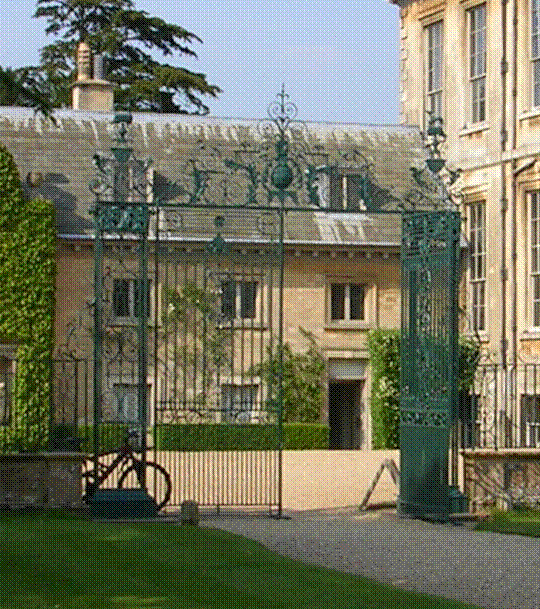
Overthrow (structure)
Encyclopedia

Wrought iron
thumb|The [[Eiffel tower]] is constructed from [[puddle iron]], a form of wrought ironWrought iron is an iron alloy with a very low carbon...
work, the overthrow, particularly popular in the Baroque
Baroque
The Baroque is a period and the style that used exaggerated motion and clear, easily interpreted detail to produce drama, tension, exuberance, and grandeur in sculpture, painting, literature, dance, and music...
era commencing in the 17th century, refers to the crowning section of ornamental wrought ironwork
Ironwork
Ironwork is any weapon, artwork, utensil or architectural feature made of iron especially used for decoration. There are two main types of ironwork wrought iron and cast iron. While the use of iron dates as far back as 4000BC, it was the Hittites who first knew how to extract it and develop weapons...
which forms a decorative crest above a wrought iron gate
Gate
A gate is a point of entry to a space enclosed by walls, or a moderately sized opening in a fence. Gates may prevent or control entry or exit, or they may be merely decorative. Other terms for gate include yett and port...
; the overthrow provides some stabilizing structure tying together supporting pier
Pier (architecture)
In architecture, a pier is an upright support for a superstructure, such as an arch or bridge. Sections of wall between openings function as piers. The simplest cross section of the pier is square, or rectangular, although other shapes are also common, such as the richly articulated piers of Donato...
s on either side of the swinging sections. The piers may be masonry or of assembled sections of wrought iron. Aside from this stabilizing feature, the overthrow was largely freed of constraints of barring passage of animals or people. Consequently, the iron master was free to express his fancy. Overthrows often feature monogram
Monogram
A monogram is a motif made by overlapping or combining two or more letters or other graphemes to form one symbol. Monograms are often made by combining the initials of an individual or a company, used as recognizable symbols or logos. A series of uncombined initials is properly referred to as a...
s or cypher
Cypher
Not to be confused with CipherCypher may refer to:* A royal cypher or monogram-like glyph-Art and entertainment:* Cypher , a Goa trance music group* Cypher , an Australian instrumental band* Cypher , a 2002 film...
s, armorial
crest
Crest (heraldry)
A crest is a component of an heraldic display, so called because it stands on top of a helmet, as the crest of a jay stands on the bird's head....
s or supporters, and even fully realized coats of arms
Coat of arms
A coat of arms is a unique heraldic design on a shield or escutcheon or on a surcoat or tabard used to cover and protect armour and to identify the wearer. Thus the term is often stated as "coat-armour", because it was anciently displayed on the front of a coat of cloth...
.

- Chirk CastleChirk CastleChirk Castle is a castle located at Chirk, Wrexham, Wales.The castle was built in 1295 by Roger Mortimer de Chirk, uncle of Roger Mortimer, 1st Earl of March as part of King Edward I's chain of fortresses across the north of Wales. It guards the entrance to the Ceiriog Valley...
, Denbigh. 1719. By Robert DaviesDavies brothers of WrexhamThe Davies brothers of Wrexham, north Wales, were a family of smiths active in the 18th century. They were particularly known for their high-quality work in wrought iron, of which several examples still survive in country homes and churchyards around the England-Wales border.The family consisted of...
, a pupil of Jean TijouJean TijouJean Tijou was a French Huguenot ironworker. He is known solely through his work in England, where he worked on several of the key English Baroque buildings. He arrived in England in c.1689 and enjoyed the patronage of William and Mary for whom he made gates and railings for Hampton Court Palace....
. - LeeswoodLeeswoodLeeswood is a small village and community in Flintshire, North Wales, about four miles from the historic market town of Mold. At the 2001 Census, the population was 2,143....
, Mold, Clwyd. The "White Gates". 1726 By Robert Davies. - Eaton HallEaton Hall (Cheshire)Eaton Hall is the country house of the Duke of Westminster. It is set within a large estate south of the village of Eccleston, in Cheshire, England . The house is surrounded by formal gardens, parkland, farmland and woodland. The estate covers an area of about .The first substantial house was...
, Cheshire. Golden GatesGolden Gates, Eaton HallThe Golden Gates at Eaton Hall, Cheshire, England, stand at the eastern end of Belgrave Avenue . The gates with their overthrow, the screens at their sides and the associated wing lodges have been designated by English Heritage as a Grade I listed building. The gates stand in front of what...
. c. 1730. By the Davies Brothers of Croes Foel. - Okeover HallOkeover HallOkeover Hall is a privately owned Grade II* listed country house in Staffordshire. It is the family seat of the Okeover family, who have been in residence since the reign of William Rufus. The house lies at the border of Staffordshire and Derbyshire, which lies on the far side of the small River Dove...
, Staffordshire. 1756. By Benjamin Yates, a pupil of Robert BakewellRobert Bakewell (ironsmith)Robert Bakewell was an English smith. He took an apprenticeship in London as an iron worker and became an extremely skilled ironsmith.In 1706, he started working at Melbourne Hall for Thomas Coke, and living in the town of Melbourne...

